Sailboat Parts Explained: Illustrated Guide (with Diagrams)
When you first get into sailing, there are a lot of sailboat parts to learn. Scouting for a good guide to all the parts, I couldn't find any, so I wrote one myself.
Below, I'll go over each different sailboat part. And I mean each and every one of them. I'll walk you through them one by one, and explain each part's function. I've also made sure to add good illustrations and clear diagrams.
This article is a great reference for beginners and experienced sailors alike. It's a great starting point, but also a great reference manual. Let's kick off with a quick general overview of the different sailboat parts.

General Overview
The different segments
You can divide up a sailboat in four general segments. These segments are arbitrary (I made them up) but it will help us to understand the parts more quickly. Some are super straightforward and some have a bit more ninja names.
Something like that. You can see the different segments highlighted in this diagram below:

The hull is what most people would consider 'the boat'. It's the part that provides buoyancy and carries everything else: sails, masts, rigging, and so on. Without the hull, there would be no boat. The hull can be divided into different parts: deck, keel, cabin, waterline, bilge, bow, stern, rudder, and many more.
I'll show you those specific parts later on. First, let's move on to the mast.

Sailboats Explained
The mast is the long, standing pole holding the sails. It is typically placed just off-center of a sailboat (a little bit to the front) and gives the sailboat its characteristic shape. The mast is crucial for any sailboat: without a mast, any sailboat would become just a regular boat.
I think this segment speaks mostly for itself. Most modern sailboats you see will have two sails up, but they can carry a variety of other specialty sails. And there are all kinds of sail plans out there, which determine the amount and shape of sails that are used.
The Rigging
This is probably the most complex category of all of them.
Rigging is the means with which the sails are attached to the mast. The rigging consists of all kinds of lines, cables, spars, and hardware. It's the segment with the most different parts.
The most important parts
If you learn anything from this article, here are the most important parts of any sailboat. You will find all of these parts in some shape or form on almost any sailboat.

Okay, we now have a good starting point and a good basic understanding of the different sailboat parts. It's time for the good stuff. We're going to dive into each segment in detail.
Below, I'll go over them one by one, pointing out its different parts on a diagram, listing them with a brief explanation, and showing you examples as well.
After reading this article, you'll recognize every single sailboat part and know them by name. And if you forget one, you're free to look it up in this guide.

On this page:
The hull is the heart of the boat. It's what carries everything: the mast, the sails, the rigging, the passengers. The hull is what provides the sailboat with its buoyancy, allowing it to stay afloat.
Sailboats mostly use displacement hulls, which is a shape that displaces water when moving through it. They are generally very round and use buoyancy to support its own weight. These two characteristics make sure it is a smooth ride.
There are different hull shapes that work and handle differently. If you want to learn more about them, here's the Illustrated Guide to Boat Hull Types (with 11 Examples ). But for now, all we need to know is that the hull is the rounded, floating part of any sailboat.
Instead of simply calling the different sides of a hull front, back, left and right , we use different names in sailing. Let's take a look at them.

The bow is the front part of the hull. It's simply the nautical word for 'front'. It's the pointy bit that cuts through the water. The shape of the bow determines partially how the boat handles.
The stern is the back part of the hull. It's simply the nautical word for 'back'. The shape of the stern partially determines the stability and speed of the boat. With motorboats, the stern lies deep inside the water, and the hull is flatter aft. Aft also means back. This allows it to plane, increasing the hull speed. For sailboats, stability is much more important, so the hull is rounded throughout, increasing its buoyancy and hydrodynamic properties.
The transom is the backplate of the boat's hull. It's the most aft (rear) part of the boat.
Port is the left side of a sailboat.
Starboard is the right side of a sailboat
The bilges are the part where the bottom and the sides of the hull meet. On sailboats, these are typically very round, which helps with hydrodynamics. On powerboats, they tend to have an angle.
The waterline is the point where the boat's hull meets the water. Generally, boat owners paint the waterline and use antifouling paint below it, to protect it from marine growth.
The deck is the top part of the boat's hull. In a way, it's the cap of the boat, and it holds the deck hardware and rigging.
Displacement hulls are very round and smooth, which makes them very efficient and comfortable. But it also makes them very easy to capsize: think of a canoe, for example.
The keel is a large fin that offsets the tendency to capsize by providing counterbalance. Typically, the keel carries ballast in the tip, creating a counterweight to the wind's force on the sails.
The rudder is the horizontal plate at the back of the boat that is used to steer by setting a course and maintaining it. It is connected to the helm or tiller.
Tiller or Helm
- The helm is simply the nautical term for the wheel.
- The tiller is simply the nautical term for the steering stick.
The tiller or helm is attached to the rudder and is used to steer the boat. Most smaller sailboats (below 30') have a tiller, most larger sailboats use a helm. Large ocean-going vessels tend to have two helms.
The cockpit is the recessed part in the deck where the helmsman sits or stands. It tends to have some benches. It houses the outside navigation and systems interfaces, like the compass, chartplotter, and so on. It also houses the mainsheet traveler and winches for the jib. Most boats are set up so that the entire vessel can be operated from the cockpit (hence the name). More on those different parts later.
Most larger boats have some sort of roofed part, which is called the cabin. The cabin is used as a shelter, and on cruising sailboats you'll find the galley for cooking, a bed, bath room, and so on.
The mast is the pole on a sailboat that holds the sails. Sailboats can have one or multiple masts, depending on the mast configuration. Most sailboats have only one or two masts. Three masts or more is less common.
The boom is the horizontal pole on the mast, that holds the mainsail in place.
The sails seem simple, but actually consist of many moving parts. The parts I list below work for most modern sailboats - I mean 90% of them. However, there are all sorts of specialty sails that are not included here, to keep things concise.

The mainsail is the largest sail on the largest mast. Most sailboats use a sloop rigging (just one mast with one bermuda mainsail). In that case, the main is easy to recognize. With other rig types, it gets more difficult, since there can be multiple tall masts and large sails.
If you want to take a look at the different sail plans and rig types that are out there, I suggest reading my previous guide on how to recognize any sailboat here (opens in new tab).
Sail sides:
- Leech - Leech is the name for the back side of the sail, running from the top to the bottom.
- Luff - Luff is the name for the front side of the sail, running from the top to the bottom.
- Foot - Foot is the name for the lower side of the sail, where it meets the boom.
Sail corners:
- Clew - The clew is the lower aft (back) corner of the mainsail, where the leech is connected to the foot. The clew is attached to the boom.
- Tack - The tack is the lower front corner of the mainsail
- Head - The head is the top corner of the mainsail
Battens are horizontal sail reinforcers that flatten and stiffen the sail.
Telltales are small strings that show you whether your sail trim is correct. You'll find telltales on both your jib and mainsail.
The jib is the standard sized headsail on a Bermuda Sloop rig (which is the sail plan most modern sailboats use).
As I mentioned: there are all kinds, types, and shapes of sails. For an overview of the most common sail types, check out my Guide on Sail Types here (with photos).
The rigging is what is used to attach your sails and mast to your boat. Rigging, in other words, mostly consists of all kinds of lines. Lines are just another word for ropes. Come to think of it, sailors really find all kinds of ways to complicate the word rope ...
Two types of rigging
There are two types of rigging: running and standing rigging. The difference between the two is very simple.
- The running rigging is the rigging on a sailboat that's used to operate the sails. For example, the halyard, which is used to lower and heave the mainsail.
- The standing rigging is the rigging that is used to support the mast and sail plan.
Standing Rigging

Here are the different parts that belong to the standing rigging:
- Forestay or Headstay - Line or cable that supports the mast and is attached to the bow of the boat. This is often a steel cable.
- Backstay - Line or cable that supports the mast and is attached to the stern of the boat. This is often a steel cable.
- Sidestay or Shroud - Line or cable that supports the mast from the sides of the boat. Most sailboats use at least two sidestays (one on each side).
- Spreader - The sidestays are spaced to steer clear from the mast using spreaders.
Running Rigging: different words for rope
Ropes play a big part in sailing, and especially in control over the sails. In sailboat jargon, we call ropes 'lines'. But there are some lines with a specific function that have a different name. I think this makes it easier to communicate with your crew: you don't have to define which line you mean. Instead, you simply shout 'mainsheet!'. Yeah, that works.
Running rigging consists of the lines, sheets, and hardware that are used to control, raise, lower, shape and manipulate the sails on a sailboat. Rigging varies for different rig types, but since most sailboats are use a sloop rig, nearly all sailboats use the following running rigging:

- Halyards -'Halyard' is simply the nautical name for lines or ropes that are used to raise and lower the mainsail. The halyard is attached to the top of the mainsail sheet, or the gaffer, which is a top spar that attaches to the mainsail. You'll find halyards on both the mainsail and jib.
- Sheets - 'Sheet' is simply the nautical term for lines or ropes that are used to set the angle of the sail.
- Mainsheet - The line, or sheet, that is used to set the angle of the mainsail. The mainsheet is attached to the Mainsheet traveler. More on that under hardware.
- Jib Sheet - The jib mostly comes with two sheets: one on each side of the mast. This prevents you from having to loosen your sheet, throwing it around the other side of the mast, and tightening it. The jib sheets are often controlled using winches (more on that under hardware).
- Cleats are small on-deck hooks that can be used to tie down sheets and lines after trimming them.
- Reefing lines - Lines that run through the mainsail, used to put a reef in the main.
- The Boom Topping Lift is a line that is attached to the aft (back) end of the boom and runs to the top of the mast. It supports the boom whenever you take down the mainsail.
- The Boom Vang is a line that places downward tension on the boom.
There are some more tensioning lines, but I'll leave them for now. I could probably do an entire guide on the different sheets on a sailboat. Who knows, perhaps I'll write it.
This is a new segment, that I didn't mention before. It's a bit of an odd duck, so I threw all sorts of stuff into this category. But they are just as important as all the other parts. Your hardware consists of cleats, winches, traveler and so on. If you don't know what all of this means, no worries: neither did I. Below, you'll find a complete overview of the different parts.
Deck Hardware

Just a brief mention of the different deck hardware parts:
- Pulpits are fenced platforms on the sailboat's stern and bow, which is why they are called the bow pulpit and stern pulpit here. They typically have a solid steel framing for safety.
- Stanchons are the standing poles supporting the lifeline , which combined for a sort of fencing around the sailboat's deck. On most sailboats, steel and steel cables are used for the stanchons and lifelines.
Mainsheet Traveler
The mainsheet traveler is a rail in the cockpit that is used to control the mainsheet. It helps to lock the mainsheet in place, fixing the mainsails angle to the wind.

If you're interested in learning more about how to use the mainsheet traveler, Matej has written a great list of tips for using your mainsheet traveler the right way . It's a good starting point for beginners.
Winches are mechanical or electronic spools that are used to easily trim lines and sheets. Most sailboats use winches to control the jib sheets. Modern large sailing yachts use electronic winches for nearly all lines. This makes it incredibly easy to trim your lines.

You'll find the compass typically in the cockpit. It's the most old-skool navigation tool out there, but I'm convinced it's also one of the most reliable. In any way, it definitely is the most solid backup navigator you can get for the money.

Want to learn how to use a compass quickly and reliably? It's easy. Just read my step-by-step beginner guide on How To Use a Compass (opens in new tab .
Chartplotter
Most sailboats nowadays use, besides a compass and a map, a chartplotter. Chartplotters are GPS devices that show a map and a course. It's very similar to your normal car navigation.

Outboard motor
Most sailboats have some sort of motor to help out when there's just the slightest breeze. These engines aren't very big or powerful, and most sailboats up to 32' use an outboard motor. You'll find these at the back of the boat.

Most sailboats carry 1 - 3 anchors: one bow anchor (the main one) and two stern anchors. The last two are optional and are mostly used by bluewater cruisers.

I hope this was helpful, and that you've gained a good understanding of the different parts involved in sailing. I wanted to write a good walk-through instead of overwhelming you with lists and lists of nautical terms. I hope I've succeeded. If so, I appreciate any comments and tips below.
I've tried to be as comprehensive as possible, without getting into the real nitty gritty. That would make for a gigantic article. However, if you feel I've left something out that really should be in here, please let me know in the comments below, so I can update the article.
I own a small 20 foot yacht called a Red witch made locally back in the 70s here in Western Australia i found your article great and enjoyed reading it i know it will be a great help for me in my future leaning to sail regards John.
David Gardner
İ think this is a good explanation of the difference between a ”rope” and a ”line”:
Rope is unemployed cordage. In other words, when it is in a coil and has not been assigned a job, it is just a rope.
On the other hand, when you prepare a rope for a specific task, it becomes employed and is a line. The line is labeled by the job it performs; for example, anchor line, dock line, fender line, etc.
Hey Mr. Buckles
I am taking on new crew to race with me on my Flying Scot (19ft dingy). I find your Sailboat Parts Explained to be clear and concise. I believe it will help my new crew learn the language that we use on the boat quickly without being overwhelmed.
PS: my grandparents were from Friesland and emigrated to America.
Thank you Shawn for the well written, clear and easy to digest introductory article. Just after reading this first article I feel excited and ready to set sails and go!! LOL!! Cheers! Daniel.
steve Balog
well done, chap
Great intro. However, the overview diagram misidentifies the cockpit location. The cockpit is located aft of the helm. Your diagram points to a location to the fore of the helm.
William Thompson-Ambrose
An excellent introduction to the basic anatomy and function of the sailboat. Anyone who wants to start sailing should consider the above article before stepping aboard! Thank-you
James Huskisson
Thanks for you efforts mate. We’ve all got to start somewhere. Thanks for sharing. Hoping to my first yacht. 25ft Holland. Would love to cross the Bass Strait one day to Tasmania. 👌 Cheers mate
Alan Alexander Percy
thankyou ijust aquired my first sailboat at 66yrs of age its down at pelican point a beautifull place in virginia usa my sailboat is a redwing 30 if you are ever in the area i wouldnt mind your guidance and superior knowledge of how to sail but iam sure your fantastic article will help my sailboat is wings 30 ft
Thanks for quick refresher course. Having sailed in California for 20+ years I now live in Spain where I have to take a spanish exam for a sailboat license. Problem is, it’s only in spanish. So a lot to learn for an old guy like me.
Very comprehensive, thank you
Your article really brought all the pieces together for me today. I have been adventuring my first sailing voyage for 2 months from the Carolinas and am now in Eleuthera waiting on weather to make the Exumas!!! Great job and thanks
Helen Ballard
I’ve at last found something of an adventure to have in sailing, so I’m starting at the basics, I have done a little sailing but need more despite being over 60 life in the old dog etc, thanks for your information 😊
Barbara Scott
I don’t have a sailboat, neither do l plan to literally take to the waters. But for mental exercise, l have decided to take to sailing in my Bermuda sloop, learning what it takes to become a good sailor and run a tight ship, even if it’s just imaginary. Thank you for helping me on my journey to countless adventures and misadventures, just to keep it out of the doldrums! (I’m a 69 year old African American female who have rediscovered why l enjoyed reading The Adventures of Robert Louis Stevenson as well as his captivating description of sea, wind, sailboat,and sailor).
Great article and very good information source for a beginner like me. But I didn’t find out what I had hoped to, which is, what are all those noisy bits of kit on top of the mast? I know the one with the arrow is a weather vane, but the rest? Many thanks, Jay.
Louis Cohen
The main halyard is attached to the head of the mainsail, not the to the mainsheet. In the USA, we say gaff, not gaffer. The gaff often has its own halyard separate from the main halyard.
Other than that it’s a nice article with good diagrams.
A Girl Who Has an Open Sail Dream
Wow! That was a lot of great detail! Thank you, this is going to help me a lot on my project!
Hi, good info, do u know a book that explains all the systems on a candc 27,
Emma Delaney
As a hobbyist, I was hesitant to invest in expensive CAD software, but CADHOBBY IntelliCAD has proven to be a cost-effective alternative that delivers the same quality and performance.
https://www.cadhobby.com/
Leave a comment
You may also like, guide to understanding sail rig types (with pictures).
There are a lot of different sail rig types and it can be difficult to remember what's what. So I've come up with a system. Let me explain it in this article.

The Ultimate Guide to Sail Types and Rigs (with Pictures)

The Illustrated Guide To Boat Hull Types (11 Examples)

How To Live On a Boat For Free: How I'd Do It

How To Live on a Sailboat: Consider These 5 Things
Own your first boat within a year on any budget.
A sailboat doesn't have to be expensive if you know what you're doing. If you want to learn how to make your sailing dream reality within a year, leave your email and I'll send you free updates . I don't like spam - I will only send helpful content.
Ready to Own Your First Boat?
Just tell us the best email address to send your tips to:

Parts of a Boat Explained
Captain tyler brady.
- October 5, 2022
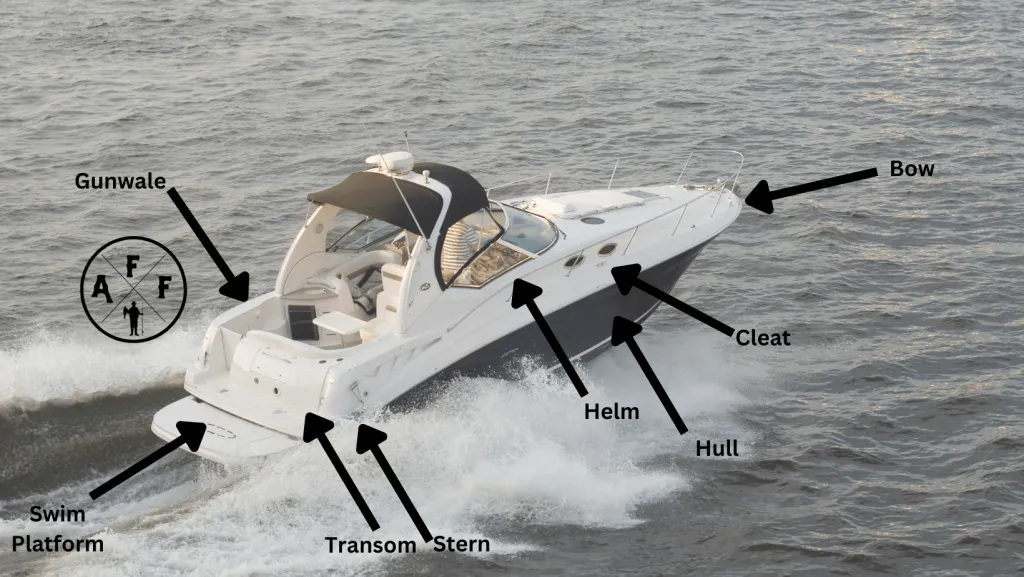
Boat enthusiasts and first-time boat buyers, this post is for you!
We’re going to break down the anatomy of a boat so that you have a better understanding of where different areas are on the vessel. This list will help you when it comes time to buy your boat or speak with a professional about maintaining your boat.
Learning about the parts of a boat is the first step on your journey to becoming an expert in all things boating!
Refer to the list to learn all the different boat parts!
Parts of a Boat Defined
- Aft – The back/stern of the boat
- Beam – The beam of a boat is its width at its widest point
- Bridge – The bridge is an elevated area on the boat where the captain steers the vessel. It’s also a great place to get a good view of everything around you.
- Bow – The bow is the front or forward part of the vessel
- Bilge – The bilge is the lowest internal part of a boat’s hull
- Bulkhead – A bulkhead is a wall that divides compartments on a boat
- Cabin – A cabin is an interior part of a boat that can be enclosed and is often used as a place to sleep while onboard a vessel
- Casting Deck/ Swim Platform – A casting deck or swim platform is the area at the bow or stern of the boat designated for casting while fishing or for entering and exiting the water while swimming.
- Cleat – A cleat is a fitting located on the gunwale of a boat or dock used to secure a rope for anchors, docking, fenders, etc.
- Deadrise – The deadrise of a boat is the angle between the hull and the keel
- Deck – The deck is the flat walking surface of a boat
- Forward – The front part of a boat
- Freeboard – Freeboard is the distance from the waterline to the deck of a vessel.
- Hatch – A hatch is an opening in the deck that provides access to parts of a boat below deck like storage compartments
- Head – The head is a room on a vessel that contains a toilet and sink
- Helm – The helm is the area of a boat where the captain or primary operator stands while driving or piloting the vessel
- Hull – The boat hull is the main body of the vessel that keeps it afloat
- Keel – The keel is a structural element located at the bottom centerline of a boat that helps with stabilization and tracking.
- Livewell – A Livewell is a tank on a fishing boat that is used to store live bait
- Port Side – Port side is the left side of a boat when looking towards the bow.
- Propeller – The propeller is a device located at the stern of a vessel that provides thrust to move the boat through the water
- Pulpit – The pulpit is a railing located at the bow of a vessel
- Running Lights – Running lights are navigation lights located at a vessel’s bow that indicate which way the vessel is moving.
- Starboard Side – Starboard side is the right side of a boat when you are looking towards the bow.
- Stern – The stern is the back or aft part of a vessel.
- Superstructure -The superstructure is the area above the deck that contains the cabin, bridge, hatches, etc. (more commonly used with larger ships compared to a personal watercraft)
- Throttle – The throttle is a lever located at the helm that controls the speed of the vessel
- Rub Rail – A rub rail is a protective trim piece located along a vessel’s gunwale that helps protect the hull from impact.
- Transom – The transom is the flat area located at the stern of the vessel where the outboard motor is mounted
- Waterline – The waterline is the line where the hull of a vessel meets the water’s surface
- Windshield – The windshield is a glass or Lexan panel located at the bow of a boat that helps to deflect wind and spray while underway
- Underside – The underside is the bottom of the hull that is below the waterline
Wrapping Up
There you have it! A complete list of the different parts that make up the anatomy of a boat. Of course, many more details and pieces make up a vessel, but these are the main components you should be familiar with. Now that you know your way around a bit, and become familiar with safe boating practices , then it’s time to get out there and enjoy boating!
Check out the following pages for guides on all the fishing gear you need to get out on the water:
- Best Fish Finders
- Best Fishing Rods
- Best Fishing Reels
- Best Fishing Line
Save 40% on fishing and outdoor gear!
We have partnered with Bass Pro Shops to offer the best deals on high-quality fishing and outdoor gear to our readers. If you click on the button below, we will take you to their exclusive discount page.

Octopus Hooks vs Circle Hooks: Unraveling the Key Differences

Fishing Sinker Weight Chart: Essential Guide for Anglers

Graphite vs Carbon Fiber Fishing Rods: A Comprehensive Comparison for Anglers


Fishing Rods Storage Ideas: Efficient Solutions for Anglers

Best Bass Boat Brands: Top Picks and Expert Insights

Fishing Reels Made in the USA: Comprehensive Guide and Top Picks

Types of Fishing Hooks: Essential Guide for Anglers

World Record Snook: Unveiling the Impressive Catch of a Lifetime
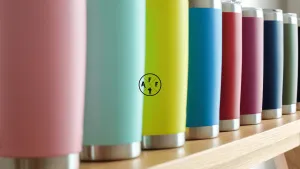
Hydroflask vs YETI Tumbler: The Ultimate Comparison Guide
Leave a comment cancel reply.
Save my name, email, and website in this browser for the next time I comment.
42 Main Parts of Boat (Name & Terminology)
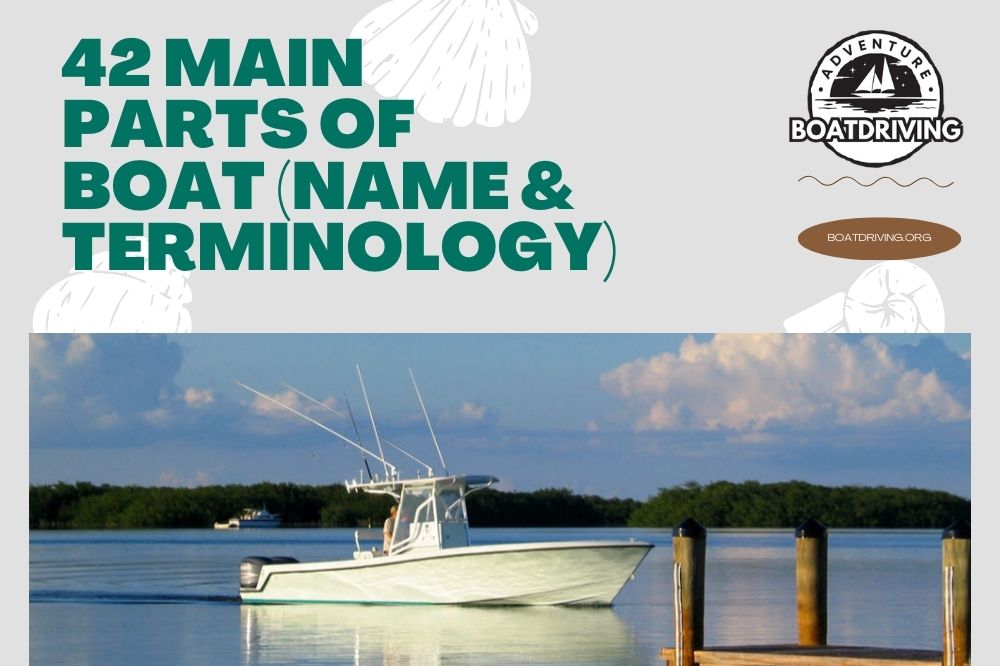
When you’re new to boating, it can seem like everyone is speaking a foreign language. And with the jargon ranging from everyday words to literal Latin terms, it can be tough to figure out the basics! That’s where we come in. We’re going to guide you on the most important boating parts and terminology. Once we’re done, you’ll be chatting on the docks like a pro!
Section One: Boat Parts
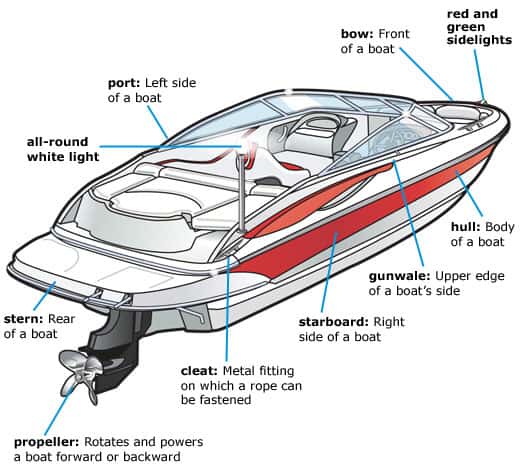
We’ll start with the crucial parts of a boat. Some of these parts can be found in ships too, but we’re staying with the basics. For reference, a boat is smaller than a ship and mostly operates in-shore with oars, propellers, and/or a small motor . To put it simply, a ship can carry a boat, but a boat can’t carry a ship. We’ll look at the typical parts of speed boats and sailboats.
Let’s begin with the directional parts of the boat : up, down, left, right, front, and back.
- Bow – front part of the boat
- Stern – back part of the boat
- Port – left side of the boat
- Starboard – right side of the boat
You can tell which side is port and which side is starboard by looking at the lights. The portlight is red and the starboard light is green. You can also use this information when you’re thinking about right-of-way in boating. Just like traffic, green means go and red means stop.
So the boat that’s on the starboard side (i.e. the boat that’s on your right) always has the right of way. Now let’s name the boat parts from the bottom to the top of the boat. Think of scanning the boat with your eyes, starting at its highest point and working your way down.
- Bulkhead – the ‘side walls’ of the boat
- Gunwale – sometimes called the gunnel, it’s the bulkhead
- Deck – the upper surface where you sit or walk
- Hull – the outer bottom of the boat, it’s the part that touches the water
- Bilge – the inner bottom of the boat above the hull
- Keel – the spine or backbone of the boat, it stays underwater
- Transom – the outer part of the stern where you attach an outboard motor
- Aft – the inner part of the stern where seats and gear are placed
- Forward – the inner part of the bow where seats or harpoons are placed
- Beam – the width or breadth of the boat at its widest part
- Freeboard – the physical distance between the gunwale and the water’s surface
- Line – another name for rope or rigging on a boat
Next, we’ll look through the functional parts of a typical boat, whether it has sails or engines.
- Anchor – a heavy device that sinks to the waterbed to hold the boat in place
- Helm – the steering wheel , bridge, or console that controls the boat
- Cockpit – another name for the enclosed area that steers the boat (console, bridge)
- Cleats – metal fixtures where you tie your docking lines
- All-round light – a white light that illuminates the whole boat
- Propeller – a submerged rotor that moves the boat forward (aka prop)
- Cabin – that’s the section where you sleep, often under the deck
- Galley – the kitchen of the boat, usually below deck
- Head – the toilet section of the boat, usually below deck
- V-berth – a v-shaped bed in the cabin that often folds into a chair or table
- Fenders – removable side cushions that are plastic or inflatable buoys
- Hatch – a door or gateway that lets you access the lower or inner parts of the boat
- Rod holder – think of cup holders, but these are for fishing rods
- Livewell – a section filled with water for storing live fish
- Swim platform – a flat section at the stern where you can get into or out of the water
Okay, now we want to talk about how the boat moves, whether it uses a sail or an engine, sometimes both. Just to be clear, all boats have propellers, but this could be a ski, outboard, inboard, stern, or duo propeller. We’ll go into detail in section two. For now, let’s talk sails.
Sailboats have the same parts as speed boats , but they also have extra parts. These include sail cloths and other functional components that facilitate analog sailing. Let’s check out some of these parts below. We’re going to focus on the most common parts and their roles.
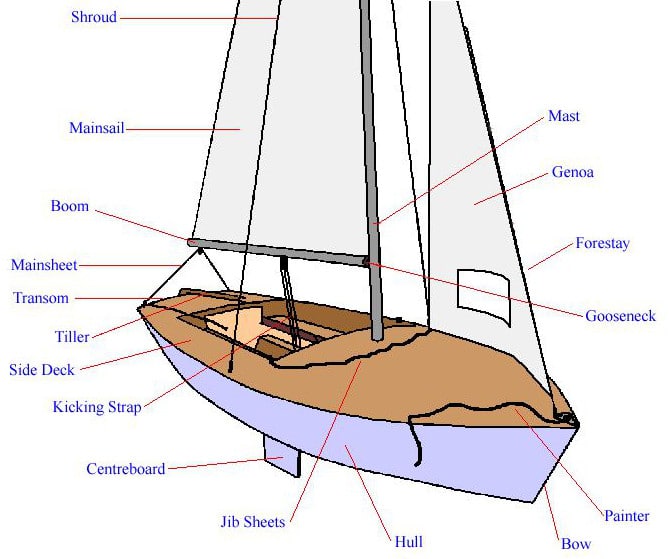
- Mainsail – the largest sailcloth
- Staysail – the smaller sailcloth, sometimes called a jib or genoa
- Battens – horizontal shafts that weave through the sailcloth to stiffen it
- Mast – the vertical pole that holds the sail cloths
- Boom – the horizontal pole that holds the sail cloths
- Gooseneck – the right-angled swivel joint between the boom and the mast
- Centerboard – a submerged section of the keel that juts downward in the middle
- Rudder – a submerged section of the keel that juts downward at the stern
- Tiller – a handle on the rudder that lets you steer the boat
- Pulpit – safety guardrails at the bow
- Pushpit – safety guardrails at the stern
If you’re looking at a sailboat (or a picture of one), you’ll notice lots of rigging. And yes, each rope has a name and a function. But they’re pretty technical, so we won’t get into that. For now, just know that sailboat ropes include a foresta y, backstay, kicking strap, and painter.
Section Two: Boating Terminology
Now that you’re familiar with the basic parts of a sailboat and speed boat, we’re going to look into the boating terms you’ll hear around the dock . You might hear them at a boat shop too, or in boating forums. Here’s a simple glossary. You’ll never feel out of your depth again!
1. The A-terms
Newbies sometimes feel boaters are ribbing them by just adding a- to everything. But these words do have meanings. Astern means steering in reverse. Ahead means moving forward. Adrift means loose and uncontrolled. Aground means unintentionally scraping the waterbed.
2. Outboard Engine
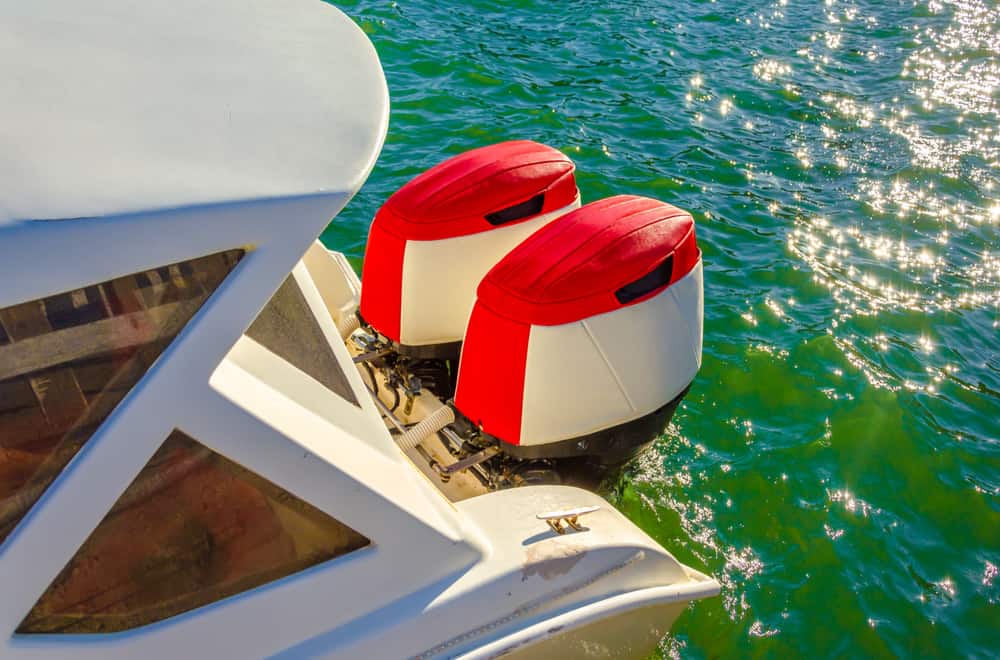
This is a type of external motor that’s visible on the surface of the boat. Outboard motors are usually attached to the transom at the back of the boat. They’re sometimes used to steer the boat. The number of outboard motors affects the knots and horsepower of your speed boat.
3. Inboard Engine
This is when the motor is hidden in a closed compartment. Inboard motors are often modified car engines that are placed in the hull and covered by the deck, with a door or hatch for engine access. You can’t use inboard motors to steel, so they’re connected to propellers.
4. Stern Drive Engine
We’ve mentioned that on some boats , you can use the outboard motor as a steering shaft. But this is only for stern drive engines where the tiller is attached to the rear motor. On ordinary outboards, there’s no steering mechanism connected to the transom engine.
5. Waterline
When a boat touches water, the bulk of the boat is above the waves while a smaller section stays submerged. The border between these sections is called the waterline. It’s the visual spot where the boat touches the topmost surface of the water body, leaving the hull below.
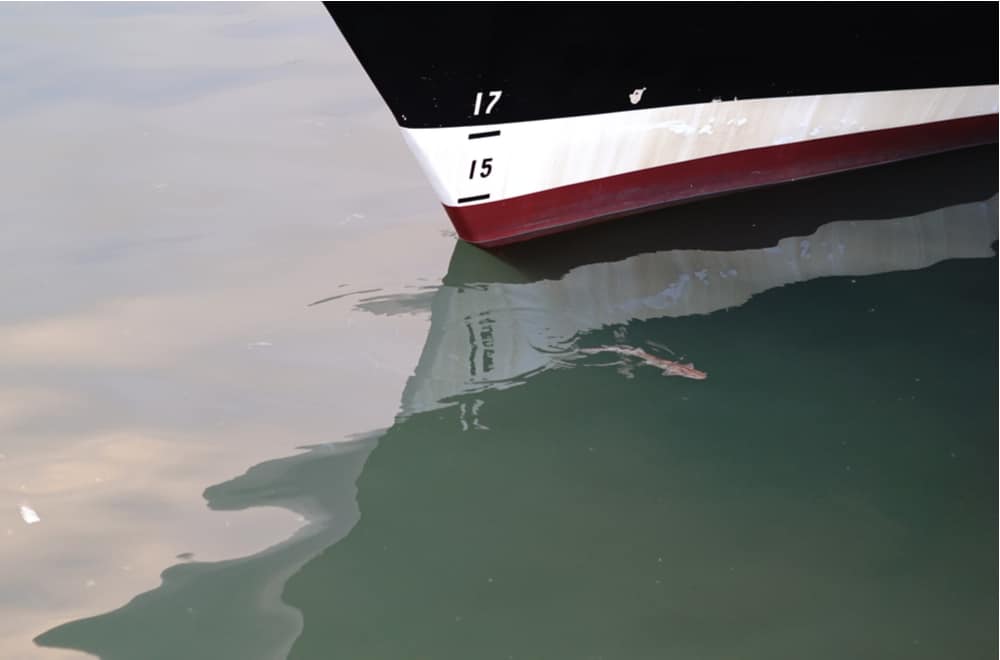
You can physically measure the part of the boat below the waterline. That distance is called the draft , and it describes how low the boat sits in the water, and how much of the boat stays submerged. Shallow draft boats (like pontoons) have 8 to 10 inches underwater at any time.
This term describes the shape and angle of the hull as it moves through the water. It can be defined as flat or round, soft or hard, with lots of overlap between. Round chines have a gentle curve (as opposed to flat hulls). Hard chines have a sharp or drastic angle e.g. V-hull.
8. Skinny Water
This is an area of shallow water where the waterbed (i.e. the ground at the bottom of the sea, ocean, pond, etc.) is roughly a foot below the surface. You’ll find a lot of skinny water inland (lakes, rivers, swamps, etc.) but you can also find skinny waters in bays, docks, or islands.
9. Choppy Water
This is deeper offshore water that’s often rough and full of waves. The currents are stronger so you need a boat that can handle these conditions. Pontoons don’t do as well in choppy water, but they rule the roost in skinny water, so that’s something to be familiar with.
10. Rigging
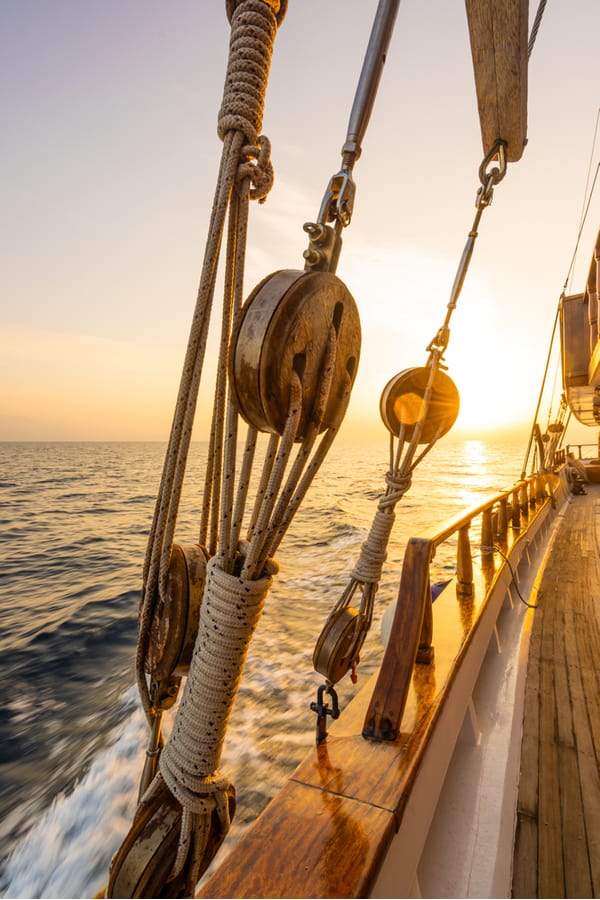
We mentioned this when we were talking about sailboat parts. The rigging is the grab-all term that describes the rope-work on any boat, but particularly a sailboat. If you’re climbing the rope-work to scale the sail, it’s described as ‘going aloft’. You’ll need to know your knots!
When you’re dropping your anchor , it’s isn’t just a matter of releasing it and you’re done. You should calculate how much of the rope or chain you need, depending on the size of your boat, depth of the water, and condition of the waterbed (rocky, sandy, etc.) This figure is the scope.
12. Mooring
The mooring is the place where your boat goes to sleep. This could be a pier, a dock, a boatyard, or even the backyard docks on waterfront properties. Sometimes, mooring means anchors and lines. But if you use it as a verb, mooring is the process of docking your boat .
13. Set the Anchor
When you drop your anchor, it helps to confirm it has a solid hold on the waterbed. Otherwise, the next time you check, your boat is gone! This process of reinforcing the anchor is called setting. Set the anchor by tugging it or by reversing the boat for 45 to 60 seconds.
14. Right of Way
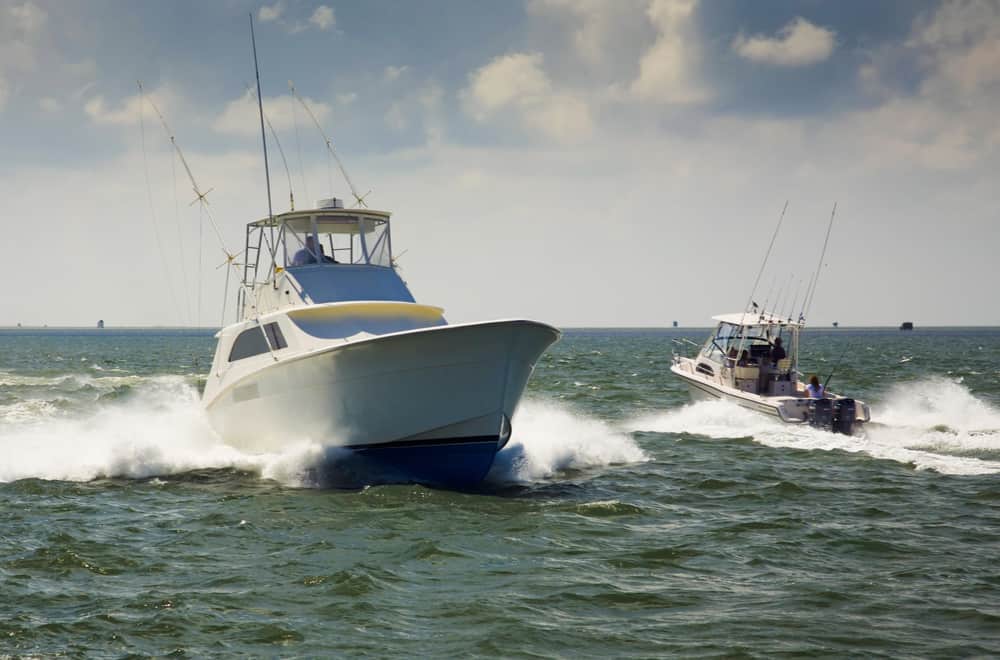
Waterways don’t have lanes like roads do. So when two boats meet , you have to use the right-of-way guidelines we mentioned earlier (aka Rules of the Road). The boat that has right of way is called the stand-on or stay-on boat, while the other boat is the stand-off or give-way.
15. Nautical Miles
No, they’re not the same as regular miles. One nautical mile is 1,852m or 6,076.12 feet. The speed of a boat is measured in nautical miles too. 1 knot is 1.15 mph, though this is often rounded off to 1.2mph. But don’t confuse speed knots with the rigging knots on the ropes.
16. Heeling and Gybing
When your boat is heeling, it means its leaning into the water and looks like it’s about to fall in. Meanwhile, to gybe (sometimes spelled as jibe) is to swing the boom. This changes how the sail cloths respond to each other and catch the wind, so it changes the boat’s direction.
17. Heading and Bearing
The heading is the direction your boat is sailing (e.g. due north, etc.) The bearing is a way of describing that heading, but you use angles and degrees. If you’re bearing off, you’re turning your boat away from the wind. But if you’re tacking, you’re turning the bow into the wind.
18. Bridge Clearance
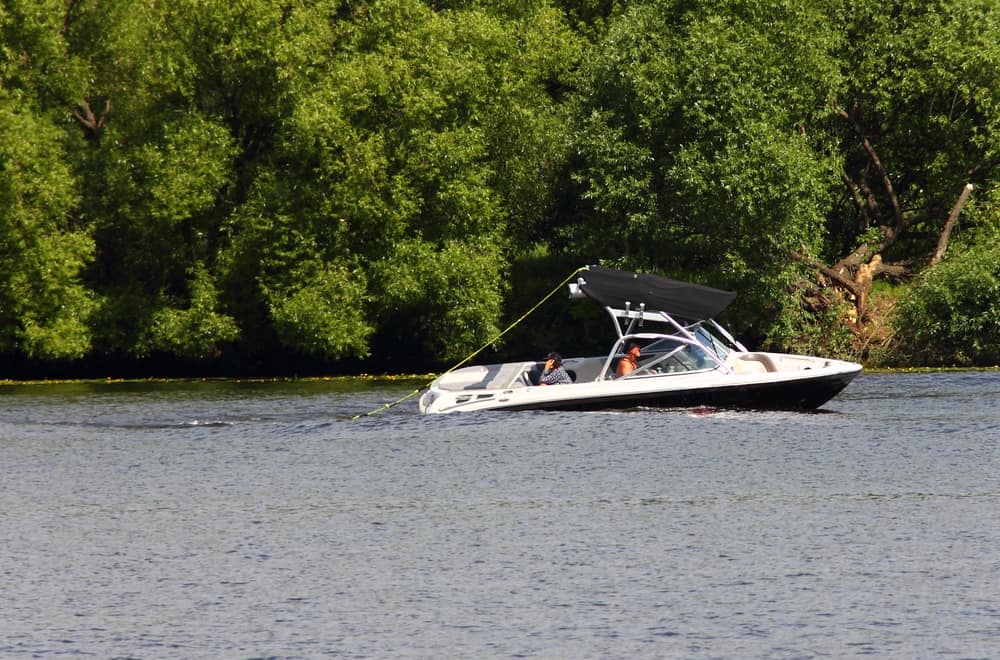
Some boats (like aluminum fishing boats or rowboats) have a flat top. Others have an open-top covered with optional canvas canopies called biminis or dodgers. But if the steering heel is enclosed in a console or bridge, the bridge clearance is the height of the tallest sub-section.
19. Roping Terms
When you’re referring to the rigging, you may hear terms like ‘make fast’ which means to secure the rope by knotting it carefully. Or ‘cast off’ which means to release the docking lines and set off. Also, the ropes on your sail cloths are sometimes described as sheets or lines.
20. Anchoring Terms
We’ve talked a bit about anchors already, but it helps to know a sea anchor is a boat brake that’s different from a regular anchor. It floats behind the boat to create drag and slow the boat. Pulling your anchor back into the boat is called retrieving or weighing your anchor.
21. Movement Terms
We’ve mentioned tacking (turning the bow), which is also called coming about. And we’ve talked about jibing (swinging the boom to turn the stern). When you tack in a zigzag to dodge wind, that’s called beating. When you drive directly into the wind, that’s called running. And when you drive your boat perpendicular to the wind (aka crosswind), that’s called reaching.
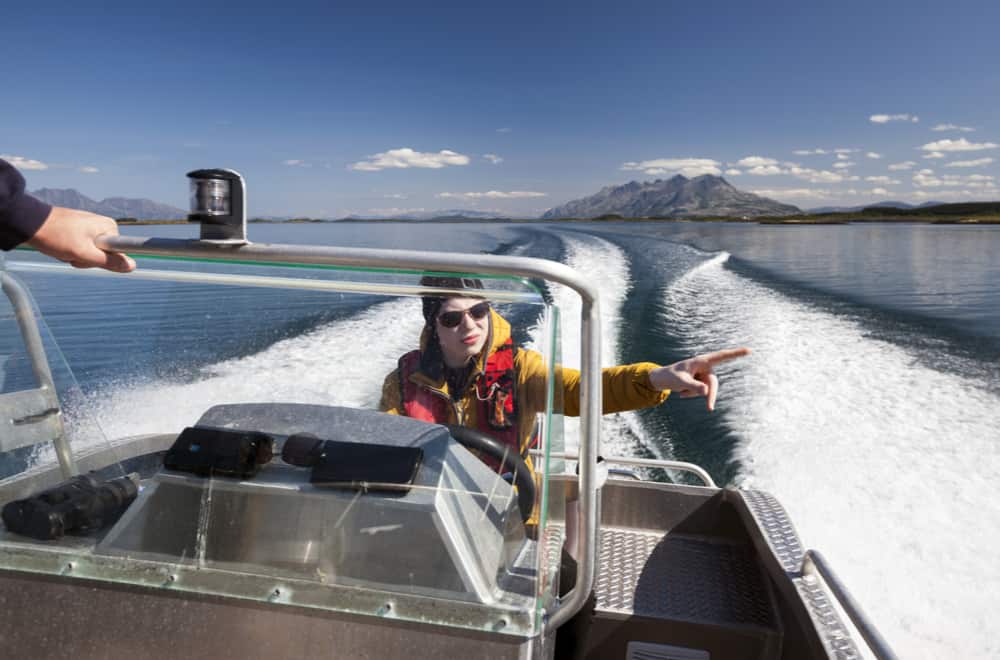
The route you’ve chosen to sail is called your course, so you can be on-course or off-course. If you’re smoothly moving forward then your boat is making headway. The waves that your propeller forms behind your boat are called the wake (hence wake surfing or wakeboarding).
23. Ballast
When a boat is sinking, you might throw cargo overboard to make the boat lighter. If you plan to retrieve these items, you can mark them with a buoy. This is called lagan. But if you add weight to the boat to make it more stable (e.g. water, stone, metal), this is called ballast.
24. Kill Switch
As a safety feature, a small lanyard ties the boat driver to the cockpit or steering wheel . If the driver leans too far back, gets distracted, or loses control, the lanyard will tighten and eventually pull away, automatically turning off the engine. Hence the name, Kill Switch.
25. Accidental / Flying Jibe
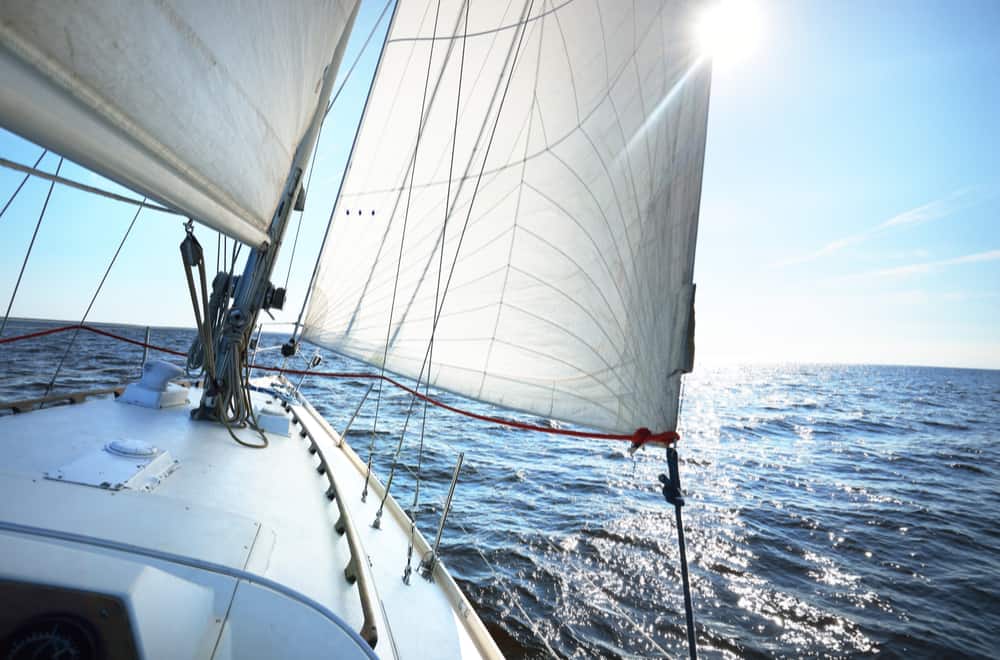
When you jibe the boat (which is the opposite of tacking), you use the boom to maneuver the stern of the boat out of the wind. But sometimes, this happens unintentionally and the boom swerves across the boat aka sailing by the lee. This mess is called accidental gybing.
Do you know any other boating parts or terminology we left out? Tell us in the comments!
Related posts:
- 6 Best Types of Boats for Gulf Coast Waters
- 21 Best Affordable Bay Boats for the Money
- Boat Club Membership Cost (Price Chart)
- 8 Tips to Choose the Best Dinghy for Your Boat
Leave a Comment Cancel reply
Save my name, email, and website in this browser for the next time I comment.
Names of Boat Parts: A Comprehensive Guide
by Emma Sullivan | Aug 18, 2023 | Sailboat Maintenance

Short answer: Names of boat parts
The names of various boat parts include bow, stern, hull, deck, mast, keel, rudder, sail, oar, hatch, cleat, and anchor. Each part serves a specific function in the operation and navigation of a boat.
Understanding the Names of Boat Parts: A Beginner’s Guide
If you’re new to boating, navigating the vast array of boat parts and their peculiar names can feel as daunting as charting unfamiliar waters. Fear not, fellow sailor! In this comprehensive beginner’s guide, we’ll dive into the depths to unravel the mysteries behind each boat part name, helping you navigate your way through this exciting world with confidence.
1. Bow – Ahoy there! Let’s start at the front of your vessel with the bow. This is the frontmost part, resembling a ship’s pointy nose. It’s important to know your bow from your stern (the back of the boat), especially when maneuvering in tight spaces or communicating effectively with fellow sailors.
2. Stern – Now that we’ve explored the bow, let’s shift our attention aftwards to the stern. Think of it as the boat’s posterior or aft end; it helps maintain stability and is often equipped with navigation lights for evening voyages.
3. Hull – The main body or shell of your boat is called its hull. It keeps you above water and acts as a floating foundation for all other vital components. You’ll want to keep an eye on its condition to ensure seaworthiness.
4. Deck – Although it might remind you of a dancefloor, a boat’s deck refers to any level surface above its hull where passengers can roam or sunbathe in style while enjoying picturesque views.
5. Cabin – Need some shelter from wind and weather? Seek refuge in your cabin! Found within a larger vessel, these enclosed spaces serve various purposes from sleeping quarters to cooking areas depending on their size and layout.
6. Mast – If you’re aiming for true sailboat authenticity, meet the mast – that towering vertical pole rising from your deck towards cloudy heights! Sails are hoisted onto masts using ropes and pulleys to harness wind power and propel your vessel.
7. Rudder – To navigate and steer your boat , we have the trusty rudder. Positioned at the stern beneath your waterline, it acts like a movable fin that turns the bow in different directions. Steering clear of any obstacles is a breeze with proper rudder control!
8. Oars/Paddles – Let’s ensure you’re equipped for any scenario on the water ! Your boat may come with oarlocks where you can insert oars or paddles to propel yourself forward manually in case engines fail or you want to enjoy some good old-fashioned rowing.
9. Cleats – Often resembling sturdy metal horns poking out from your deck or sides, cleats are used for securing ropes or tying off lines. They play an essential role in docking and keeping your boat steady.
10. Bimini Top – Ahh, shade on a sunny day! A bimini top is a retractable cover often made of fabric that extends over part of your boat’s deck using adjustable frames connected to its supports. It offers protection from excessive sunlight ensuring comfort during those scorching maritime expeditions.
Remember, this is only an introduction to the vast world of boat parts names! Learning them will not only deepen your understanding of boating but also enhance communication with other enthusiasts when exchanging exciting seafaring tales or seeking advice for repairs and upgrades.
So set sail on this thrilling adventure armed with newfound knowledge about these peculiar yet essential components ! Happy boating!
Demystifying Boat Terminology: Exploring the Names of Boat Parts
Are you a landlubber who is curious about the intricate world of boating? Have you ever found yourself puzzled by the jargon used by avid sailors and boat enthusiasts ? Fear not, for today we will embark on an adventure to demystify boat terminology . We will explore the names of various boat parts, shedding light on their functions and origins.
Firstly, let us dive into the bow. No, we’re not referring to an ancient form of greeting; in the boating realm, the bow refers to the front or forward part of a vessel. Typically pointing towards the direction of travel, it plays a vital role in cutting through water with grace and efficiency.
Moving swiftly towards the stern – no pun intended – we encounter another essential component: The transom. This term might evoke images of futuristic medical procedures, but fear not – it is simply the flat surface at the very back of a boat. The transom often houses important equipment such as engines and provides stability while cruising through waves.
As our nautical journey continues, let us delve into one particularly intriguing area: The galley. You may associate this word with culinary exploits in your kitchen ashore, but aboard a boat, it refers to an accommodating cooking area. While it may be compact compared to land-based counterparts, galleys are designed with clever storage solutions to maximize efficiency and ensure that your seafaring feasts remain deliciously memorable.
Ahoy there! Let’s not overlook what keeps a vessel adrift upon tides and currents – none other than hulls. These sturdy structures are akin to a ship’s skeleton – providing strength and buoyancy throughout its lifespan. Hull materials have evolved over time from traditional wooden frames to modern alternatives such as fiberglass or aluminum alloys. Regardless of material choice, understanding hull design is crucial for optimizing performance at sea.
Now would be an opportune moment to detour towards an elegant addition on board: the cabin. While visions of cozy wood-paneled rooms may come to mind, cabins on boats offer more than just a snug retreat. They serve as sleeping quarters and provide respite from the elements when nature is less than hospitable. Cabins can range from functional sleeping compartments in smaller crafts to luxurious suites found aboard extravagant yachts .
Next up, we set our sights on something that might make you feel like a superhero – although not quite as glamorous. Enter the cockpit, the area where the captain commandeers their aquatic vessel. This bustling hub often houses navigational instruments, controls, and seating arrangements for fellow adventurers. Whether you’re leading your crew through uncharted waters or simply soaking in the sea breeze with friends, the cockpit is where memories are made.
Lastly, we arrive at an enigmatic element – rigging. No sleuthing skills are needed here; rigging refers to all the ropes, wires, and cables used to support sails and control various parts of a boat ‘s structure. Precision and knowledge are required when handling rigging; otherwise, one might find themselves entangled like a confused spider amid its intricate web.
So there you have it – a primer on boat parts terminology designed to enlighten even the most fervent landlubber. Armed with this newfound knowledge, you’ll be able to navigate conversations about boats with flair and confidence. Happy exploring on your new seafaring journey!
Step-by-Step Breakdown: Learning the Names of Boat Parts
Title: A Nautical Journey: Step-by-Step Breakdown to Master the Names of Boat Parts
Introduction: Ahoy, aspiring sailors! Embarking on your nautical adventure but feeling a bit lost in boat jargon? Fear not, for today we will take you on a voyage of knowledge. In this comprehensive guide, we break down each and every boat part’s name with remarkable wit and cleverness. So batten down the hatches, mateys, and prepare to become fluent in nautical terminology !
1. Bow – The ship’s head-turner: Standing tall at the front of the vessel is the bow – a term derived from archery lingo. Just like Cupid’s arrow, it points forward, allowing your vessel to conquer waves and navigate with unparalleled grace.
2. Stern – The ship’s sassy tail: Opposite of the bow lies the stern. Think of it as a saucy dance partner who follows you from behind gracefully. It keeps your vessel stable and balanced when sailing against those fierce currents.
3. Hull – A multi-purpose bodyguard: The hull is nothing short of a superhero suit for your boat! This sturdy outer shell protects everything inside—keel to deck—from water penetration while providing buoyancy even amid tempestuous seas .
4. Keel – Keeping stability steady: The keel has an unwavering dedication to stability! Attached beneath the hull’s belly, its elongated shape helps counterbalance winds or change directions swiftly without capsizing—a true guardian angel for sailors.
5. Rudder – The navigator’s wingman/woman: Every captain needs their trusty sidekick! Enter rudder—the chief assistant when making turns or adjustments in direction. Positioned at the stern’s aft end, this fin-like appendage answers every helmsman’s command effortlessly.
6. Mast – Reaching for heavenly heights: The mast may look like a simple pole, but it plays a vital role in reaching for the skies. It proudly holds the sails aloft, harnessing the winds’ magical power to propel your vessel through oceanic vastness.
7. Boom – A rhythmic performer: The boom is not just something you hear on a stage—it’s also an integral part of a boat ! This horizontal spar extends backward from the mast, supporting and adjusting the tension of the mainsail with perfect rhythm.
8. Sails – Capturing nature’s breath: Behold the magnificent sails—the epitome of capturing nature’s breath! These majestic fabrics, billowing in harmony with wind currents, convert atmospheric forces into forward momentum and set sail to your wildest dreams.
9. Bowsprit – The figurative sword-wielder: Atop the bow stands a fearless warrior known as bowsprit—a projecting spar resembling a noble figurehead. With an air of elegance, it juts out like Excalibur, slicing through water while enhancing overall balance.
10. Tiller – Steering with finesse: When it comes to steering your floating steed, the tiller acts as an extension of your own hand! Connected to the rudder at one end and held by you at another, this handle controls course changes smoothly and effortlessly.
Conclusion: Congratulations on completing our whimsical journey into mastering nautical lingo ! By unraveling each boat part ‘s witty personality and clever functionality, you are now well-equipped to navigate conversations amongst salty seafarers or take helm on your very own sea adventure. So embark bravely upon those uncharted waters armed with newfound knowledge and let these boat parts guide you towards endless maritime wonders!
Frequently Asked Questions about Names of Boat Parts: Answered!
Are you new to the world of boating and finding it difficult to navigate through all the different terms used for various boat parts? Don’t worry; you’re not alone! The names of boat parts can be confusing, and understanding them is essential for proper maintenance and communication on the water.
In this blog post, we will delve into some frequently asked questions about boat part names to provide you with detailed explanations that are professional, witty, and clever. So let’s set sail on this educational journey together!
1. What is a bow?
Ah, the bow – not just a gesture but an integral part of any boat ! The bow refers to the forward or front section of a vessel. It cuts through the water as your boat gracefully moves forward, symbolizing its first line of defense against the waves. Think of it as your ship’s piercing arrowhead!
2. Tell me more about hulls.
The hull is like the protective skin that encloses your entire boat. It is typically made from fiberglass, aluminum, wood, or other sturdy materials. Picture it as your trusted shield that keeps out unwanted water while giving buoyancy to keep your vessel afloat. A mighty armor indeed!
3. Explain what gunwales are.
Let’s talk gunwales – pronounced “gunnels” (not “guns wails,” which would be quite dramatic!). Gunwales refer to the upper edges or sides of a boat’s hull where you might rest your arms while observing panoramic ocean views or casting fishing lines into open waters . They provide support and stability while adding aesthetic charm – comfortable pontoons for our weary limbs!
4. Can you unravel the mystery behind keels?
Ah yes, keels! Boating lingo gets interesting here. The keel is like a hidden rudder beneath your vessel, creating stability by counterbalancing forces like wind and waves. It helps prevent your boat from tipping over or getting carried off course – a steadfast guide that keeps you on track even when the tides are against you!
5. What about the mysterious bilge?
Ah, the depths of the boat where no sailor ventures without good reason – we speak of none other than the bilge! The bilge is the lowest part inside a vessel, often overshadowed and misunderstood. It refers to the area below deck where water collects before being pumped out. It’s like a secret chamber where any unwanted liquids gather, waiting for our trusty bilge pumps to save the day!
6. Can you shed some light on biminis?
Imagine yourself basking in sunlight while gently gliding across calm waters – this picturesque scene might involve relaxing under a bimini! A bimini is a specially designed canvas cover stretched over a metal frame to provide shade on your boat. It’s like having your personal awning at sea, shielding you from sunburn as you enjoy each blissful moment.
7. Explain propellers with flair!
Ah, propellers; they bring motion and power to our boating endeavors! Picture them as underwater fans working tirelessly to move your vessel forward or backward through water with ease. Propellers resemble finely crafted wings; hence they’re often called “screws.” They whirl at high speeds generating energy that propels your boat through waves, leaving trails of excitement behind!
And there you have it – answers to some frequently asked questions about names of boat parts unraveled with professionalism, wit, and clever explanations! We hope this informative and entertaining journey has left you feeling more confident about navigating the vast sea of boating terminology.
So next time someone mentions bow or hulls or gunwales in conversation, you’ll be equipped with knowledge worth sharing amidst laughter and fascination. Be ready to set sail into conversations about boat parts like an experienced captain – steering through the waves of confusion with ease!
Mastering the Language of Boating: Learn the Essential Names of Boat Parts
Welcome aboard, fellow boating enthusiasts! If you’ve ever been out on the open water , you know that boating isn’t just a hobby; it’s a way of life. And just like any other passion, mastering the language is key to truly immersing yourself in this world. Today, we’re going to dive deep into the nautical dictionary and explore some essential names of boat parts. So grab your captain’s hat and let’s set sail !
1. Bow: As we step onto our vessel , we start at the very front – the bow. This is where you’ll find the pointed end of most boats, slicing through the waves with finesse.
2. Stern: Ahoy, mateys! Now let’s move towards the rear – ahem, stern – of our boat . The stern is where all the action happens; it’s where you’ll find the engine and steering controls.
3. Hull: Ah, sweet hull! This refers to the main body or shell of a boat that keeps it afloat and provides structural integrity. Take care of your hull, and it will take care of you on those rough seas.
4. Propeller: Picture this – as you’re cruising along in your magnificent vessel, what’s spinning in the water behind? That’s right -it’s your trusty propeller! Responsible for generating thrust and propelling (pun intended) your boat forward.
5. Rudder: Ever wondered how boats change direction ? Look no further than the rudder! Attached to the stern (we told you it was important), this movable device helps guide your boat gracefully through tumultuous waters.
6. Anchor: Are you ready to drop anchor ? This heavy metal object does exactly what its name implies – stops your boat from drifting off when you’ve found that perfect spot for fishing or soaking up some sun.
7. Cleat: Time to tie up our floating beauty! Cleats are those handy metal or wooden fixtures scattered along the sides of your boat . They secure ropes and help maintain stability when mooring .
8. Bimini Top: Ah, shade at sea! The bimini top is a retractable cover that shields you from the scorching sun. A must-have for any boater seeking refuge during those hot summer adventures.
9. Windlass: Raise the anchor, sailor! This mechanical device tucked away in a dark corner will do all the heavy lifting for you. Just press a button, and watch as it effortlessly raises the anchor from the deep depths below.
10. Tiller: For all our sailing aficionados out there, the tiller is a vital piece of equipment that helps control your sailboat’s direction by maneuvering its rudder directly.
Congratulations! You’ve just expanded your boating vernacular by leaps and bounds. From bow to stern, hull to propeller, this list will have you speaking boat lingo like a seasoned captain in no time. So next time you’re out on the water, impress your fellow sailors with your newfound knowledge of these essential boat parts! Bon voyage!
Dive Deep into Nautical Vocabulary: Unveiling the Intricacies of Names for Boat Parts
Ahoy, fellow seafarers! If you’ve ever found yourself stumped by the enigmatic jargon of the sea, fear not. Today, we shall embark on a linguistic voyage into the depths of nautical vocabulary and unravel the intricacies of naming boat parts. So, fasten your life vests and prepare to be enlightened!
When it comes to boats, there’s no shortage of specific terms to describe every nook and cranny. Let’s start at the bow – that’s the front of the vessel for all you landlubbers out there – where we find the most iconic part: the figurehead. This ornamental carving is situated right at the prow, adding a touch of grandeur to any ship. Akin to the face of a vessel, figureheads can depict anything from fearsome mythical creatures to historical figures.
As we move aft (which means towards the rear), we encounter another important feature: the mast . Rising majestically towards the sky, a mast is essential for hoisting sails and maintaining stability on larger vessels. How else would intrepid sailors catch those fierce ocean winds? And speaking of sails, let’s not forget about their many components that allow them to billow gracefully in defiance of nature’s forces.
The rigging system plays a crucial role in supporting and adjusting sails, with various ropes and wires employed for different purposes along what is known as standing or running rigging. Think shrouds (attached horizontally from masthead to hull), stays (running diagonally from masts), halyards (used for raising or lowering sails), or sheets (controlling sail angles). Each one has its own function in maneuvering these majestic craft through tempestuous waters.
Now that our attention turns downwards, we find ourselves tracing overboard with our fingers along something called a gunwale. No pirates here! The gunwale isn’t dangerous weaponry; rather, it’s the upper edge of the boat’s sides. This sturdy structure provides both protection and support for everyone aboard, making it a vital component of any seaworthy vessel.
Now, let’s put our trusty sea legs to work as we venture below deck. Here, we uncover the delights of marine engineering and all those mechanisms that keep the ship sailing smoothly . Keel? It’s not just a word to rhyme with “feel,” but rather a foundational beam running the length of the boat. This essential part helps maintain stability by counteracting sideways forces from wind or waves.
Moving on to perhaps more mundane but equally important features, we mustn’t overlook bilges, which are simply compartments at the lowest point in the hull where water collects. Proper maintenance is crucial here; otherwise, one may find themselves dealing with unpleasant oceanic intrusions!
Not forgetting navigation enthusiasts among us, let’s sail towards an area called the bridge (not to be confused with a land-based structure). Positioned on larger ships, this elevated platform grants commanding views of the surrounding seascape while housing various instruments used for navigation and communication – think compasses, radars, radios… A veritable technological hub!
As our exploration draws to a close (for now), I hope you’ve relished this deep dive into nautical vocabulary. Understanding these names for boat parts not only enhances our appreciation for maritime craftsmanship but also ensures effective communication amidst salty adventures at sea!
So next time you’re regaled with tales of seafaring feats or embark on your own oceanic encounter, armed with your newfound knowledge of nautical jargon , you can astound your shipmates with your grasp of boat lore – and appreciate all those intricate details that make navigating through life’s tempests just a little bit easier!
Recent Posts

- Sailboat Gear and Equipment
- Sailboat Lifestyle
- Sailboat Maintenance
- Sailboat Racing
- Sailboat Tips and Tricks
- Sailboat Types
- Sailing Adventures
- Sailing Destinations
- Sailing Safety
- Sailing Techniques

IMAGES
VIDEO
COMMENTS
The hull is what most people would consider 'the boat'. It's the part that provides buoyancy and carries everything else: sails, masts, rigging, and so on. Without the hull, there would be no boat. The hull can be divided into different parts: deck, keel, cabin, waterline, bilge, bow, stern, rudder, and many more.
Bow – The bow is the front or forward part of the vessel. Bilge – The bilge is the lowest internal part of a boat’s hull. Bulkhead – A bulkhead is a wall that divides compartments on a boat. Cabin – A cabin is an interior part of a boat that can be enclosed and is often used as a place to sleep while onboard a vessel.
Let’s begin with the directional parts of the boat: up, down, left, right, front, and back. Bow – front part of the boat. Stern – back part of the boat. Port – left side of the boat. Starboard – right side of the boat. You can tell which side is port and which side is starboard by looking at the lights. The portlight is red and the ...
Bow: the front of a boat. Stern: the rear of a boat. Port: left side of a boat. Starboard: right side of a boat. Helm: the driver’s seat. Gunwale: the top of the boat’s side (upper edge). If water comes higher than the gunwale, it enters the boat. Transom: The cross-section of the rear of the boat (stern).
Short answer: Names of boat parts The names of various boat parts include bow, stern, hull, deck, mast, keel, rudder, sail, oar, hatch, cleat, and anchor. Each part serves a specific function in the operation and navigation of a boat. Understanding the Names of Boat Parts: A Beginner's GuideUnderstanding the Names of Boat Parts: A.
Hull – The hull is the watertight body of a ship or boat. It is the structure that floats a vessel and gives it its shape. Transom – The transom on a boat is the flat panel that forms the stern or back end. The transom provides both structural support and a place to mount the motor, steering system, and other hardware.